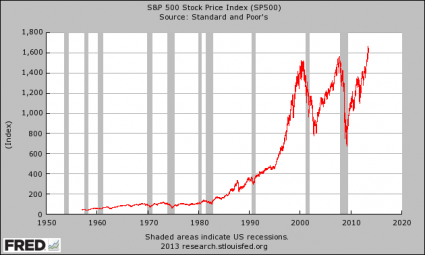When will the era of Cheap Money end? Investors are scared according to CNN.
Stocks: Pointing higher as Fed fears wane
http://money.cnn.com/2013/06/18/investing/premarkets/
By CNNMoney Staff @CNNMoneyInvestJune 18, 2013:
Related: Fear & Greed Index cowers in fear
U.S. stocks finished higher after a choppy day of trading Monday.
Investors are likely to remain on edge until they hear more from Fed chairman Ben Bernanke about the central bank's plans for its bond-buying program. Bernanke is set to speak at a news conference Wednesday after the Fed completes its two-day policy meeting.
In a PBS interview that aired late Monday, President Obama told Charlie Rose that Bernanke has "already stayed a lot longer than he wanted, or he was supposed to."
Related: Fed not expected to taper until December
When Rose asked the president if he would reappoint Bernanke as Fed chairman when his term expires next year, Obama replied, "He has been an outstanding partner along with the White House in helping us recover much stronger than, for example, our European partners from what could have been an economic crisis of epic proportions."
Whenever Margin Debt Goes Over 2.25% Of GDP The Stock Market Always Crashes
By Michael, on June 17th, 2013
What do 1929, 2000 and 2007 all have in common? Those were all years in which we saw a dramatic spike in margin debt. In all three instances, investors became highly leveraged in order to "take advantage" of a soaring stock market. But of course we all know what happened each time. The spike in margin debt was rapidly followed by a horrifying stock market crash. Well guess what? It is happening again. In April (the last month we have a number for), margin debt rose to an all-time high of more than 384 billion dollars. The previous high was 381 billion dollars which occurred back in July 2007. Margin debt is about 29 percent higher than it was a year ago, and the S&P 500 has risen by more than 20 percent since last fall. The stock market just continues to rise even though the underlying economic fundamentals continue to get worse. So should we be alarmed? Is the stock market bubble going to burst at some point? Well, if history is any indication we are in big trouble. In the past, whenever margin debt has gone over 2.25% of GDP the stock market has crashed. That certainly does not mean that the market is going to crash this week, but it is a major red flag.
The funny thing is that the fact that investors are so highly leveraged is being seen as a positive thing by many in the financial world. Some believe that a high level of margin debt is a sign that "investor confidence" is high and that the rally will continue. The following is from a recent article in the Wall Street Journal...
The rising level of debt is seen as a measure of investor confidence, as investors are more willing to take out debt against investments when shares are rising and they have more value in their portfolios to borrow against. The latest rise has been fueled by low interest rates and a 15% year-to-date stock-market rally.
Others, however, consider the spike in margin debt to be a very ominous sign. Margin debt has now risen to about 2.4 percent of GDP, and as the New York Times recently pointed out, whenever we have gotten this high before a market crash has always followed...
The first time in recent decades that total margin debt exceeded 2.25 percent of G.D.P. came at the end of 1999, amid the technology stock bubble. Margin debt fell after that bubble burst, but began to rise again during the housing boom — when anecdotal evidence said some investors were using their investments to secure loans that went for down payments on homes. That boom in margin loans also ended badly.
Posted below is a chart of the performance of the S&P 500 over the last several decades. After looking at this chart, compare it to the margin debt charts that the New York Times recently published that you can find right here. There is a very strong correlation between these charts. You can find some more charts that directly compare the level of margin debt and the performance of the S&P 500 right here. Every time margin debt has soared to a dramatic new high in the past, a stock market crash and a recession have always followed. Will we escape a similar fate this time?

My opinion: Invest in God. He pays huge dividends forever!


No comments:
Post a Comment